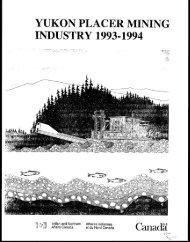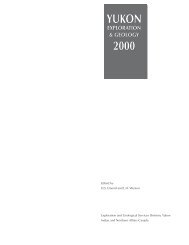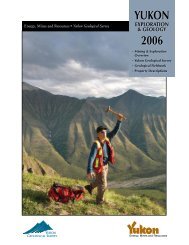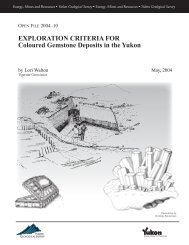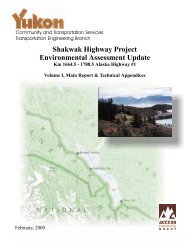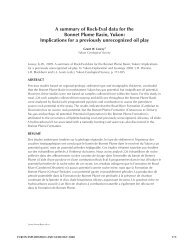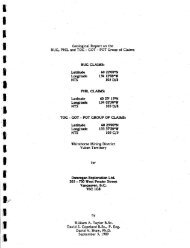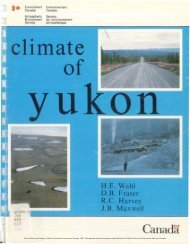Eagle_Plain_matting_..
Eagle_Plain_matting_..
Eagle_Plain_matting_..
You also want an ePaper? Increase the reach of your titles
YUMPU automatically turns print PDFs into web optimized ePapers that Google loves.
W14101001-L01-Mat Impact to Vegetation.doc<br />
W14101001<br />
March 4, 2008<br />
2<br />
During Summer Operations at Well Pads and Access Routes, Oil and Gas Exploration, <strong>Eagle</strong><br />
<strong>Plain</strong>s, Yukon” (EBA, February 2008).<br />
• Based on the above information, EBA determined that the most critical potential impacts to the<br />
soil would be alteration of physical characteristics mainly due to compaction. Chemical<br />
alteration of soil conditions would not likely occur during the short-term, one-time disturbances<br />
that are being proposed in Northern Cross’s access mat placement program. It was also<br />
determined that if ground pressures were 5 PSI or lower as described compaction would be<br />
unlikely.<br />
• All other soil parameters considered would depend on physical alteration of soil conditions not<br />
likely to occur under the conditions proposed by Northern Cross <strong>matting</strong> program.<br />
Potential Impacts of Matting on Vegetation<br />
• Potential impacts on surface vegetation could result from physical damage incurred during<br />
placement and removal of the mats or during operation if mats were to shift or slide across the<br />
ground surface. Based on the outlined assumptions above, including low ground pressure, it is<br />
unlikely that significant damage to vegetation would occur as a result of crushing.<br />
• Assuming that soil conditions are not impacted, i.e., the physical and/or chemical properties of<br />
the soil are not altered by mat placement and use, any disturbance to vegetation would represent<br />
short-term damage and would likely recover once mats were removed.<br />
• If mat use causes soil to be exposed through scraping or scuffing of the ground surface,<br />
additional vegetation issues could arise including, but not exclusive to, invasion by weedy species<br />
or alteration of the successional state of the existing vegetation community.<br />
• In order to reduce potential structural damage to vegetation with the use of access mats,<br />
seasonal changes in vegetation should be considered. In late fall sap content in limbs is reduced<br />
and moisture content of foliage is typically low. This condition can result in increased fragility<br />
and greater susceptibility to vegetation damage. Avoiding mat placement in late fall will reduce<br />
the potential structural damage to vegetation.<br />
Reclamation of Areas Impacted by Access Mat Placement<br />
• Based on the above summary of opinions it is not expected that reclamation will be necessary<br />
after mat removal. It is also likely that reclamation efforts would cause more damage than<br />
benefit and overall would defeat the purpose of access mat use in the first place.<br />
It is important to note that the above summary letter is based on EBA’s professional opinion and<br />
was determined with limited information regarding actual field application of mat roads in the <strong>Eagle</strong><br />
<strong>Plain</strong>s Area of the Yukon Territory. EBA supports Northern Cross’s proposed approach to<br />
gathering actual field information through a staged operation field trial evaluating four test sites over<br />
the early spring and summer of 2008.



